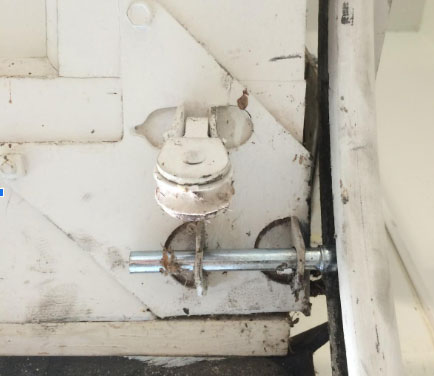An Overview of Old Garage Door Mechanisms
Do you know what this pulley is for? The first thing you need to know about this garage door is that it is very old, probably manufactured in the 50s or 60s. This pulley was on both the left and right sides of the very bottom brackets of the garage door. This pulley system was used back then to act like a strut, which is what we use today to support a garage door from sagging when it is in the up or horizontal position.
The Mechanics of Cable Stretching
What they would have to do is run a steel cable around both pulleys and utilize a tool that would stretch the cables. By stretching the cables and pulling on the corners of the bottom section of the door, they could slightly make the door bow outwards. When you can get the door to bow outwards, that much tension on the corners of the bottom section makes the door function similarly to a modern-day strut.
Transition to Modern Garage Door Systems
What has happened here is that a garage door technician cut the cables that were no longer needed. Nowadays, you can simply screw a strut to the back side of the garage door, and it will serve the same purpose. It’s comparable to the metal rod found on the top and bottom of a one-piece garage door, where tightening down the nuts puts more tension on the rod, causing the one-piece garage door to bow outwards.
Evaluating the Necessity of Old Pulleys
If your garage door has these pulleys attached to it and you think that something is missing, it probably isn’t. You should have a strut on that section in place of the old cable system that was used years ago. Since these pulleys look built into the bottom bracket of the garage door, it may be difficult to remove them. A metal cutting disc could shear it off, but it doesn’t hurt anything to keep them on.
Potential Interference with Safety Features
Unless they stick out too far inward and interfere with your infrared safety sensors for the garage door opener, it is possible to leave them alone. I’ve seen hardware on a garage door interfere with sensors, causing the door to reverse when the piece of hardware crosses the infrared beam. So, if there’s no problem with the pulleys interfering with anything, it’s okay to just leave them.
Understanding the Complexity of Older Models
It’s also possible that your garage door, if it is as old as this one, may have several sets of pulleys along the garage door to provide support to the middle and even top sections. The main reason why this garage door remains functional and intact today is that old saying: they don’t build them like they used to.
Conclusion: Inherent Value of Old Garage Doors
In summary, these old garage door systems with pulleys still hold value and functionality. Understanding their purpose can help you make informed decisions about repairs or replacements. If you’re unsure about the mechanics or safety features, consult a garage door technician for expert advice.
